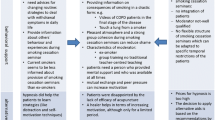Abstract
Purpose
Smoking cessation is the primary goal for managing patients with chronic obstructive pulmonary disease (COPD) who smoke. However, previous studies have demonstrated poor cessation rates. The “lung age” concept (an estimate of the age at which the FEV1 would be considered normal) was developed to present spirometry data in an understandable format and to serve as a tool to encourage smokers to quit. Primary care physicians’ (PCPs) views of using lung age to help COPD patients to quit smoking were assessed.
Methods
Post-intervention interviews were conducted with PCPs in the U.S. who participated in the randomized clinical trial, “Translating the GOLD COPD Guidelines into Primary Care Practice.”
Results
29 physicians completed the interview. Themes identified during interviews included: general usefulness of lung age for smoking cessation counseling, ease of understanding the concept, impact on patients’ thoughts of quitting smoking, and comparison to FEV1. Most providers found lung age easy to communicate. Moreover, some found the tool to be less judgmental for smoking cessation and others remarked on the merits of having a simple, tangible number to discuss with their patients. However, some expressed doubt over the long-term benefits of lung age and several others thought that there might be a potential backfire for healthy smokers if their lung age was ≤ to their chronological age.
Conclusions
This study suggests that lung age was well received by the majority of PCPs and appears feasible to use with COPD patients who smoke. However, further investigation in needed to explore COPD patients’ perspectives of obtaining their lung age to help motivate them to quit in randomized clinical trials.
Similar content being viewed by others
References
Decramer M, Janssens W, Miravitles M (2012) Chronic obstructive pulmonary disease. Lancet 379:1341–1351
Centers for Disease Control and Prevention (2012) Chronic pulmonary obstructive disease among adults – United States 2011. MMWR Morb Mortal Wkly Rep 61(46):938–942
GOLD Global strategy for diagnosis, management, and prevention of COPD, January 2014 http://www.goldcopd.org/guidelines-global-strategy-for-diagnosis-management.html. Accessed 27 Aug, 2014
Willemse BWM, Postma DS, Timens W et al (2004) The impact of smoking cessation on respiratory symptoms, lung function, hyperresponsiveness and inflammation. Eur Respir J 23:464–476
Hilbernick SR, Jacobs JE, Schlosser M, Grol RPTM, de Vries H (2006) Characteristics of participants with COPD in three motivational stages related to smoking cessation. Patient Educ Couns 61:449–457
Jimenez CA, Masa F, Miravitlles M, Gabriel R, Veijo JL, Villasante C, Sobradillo V (2001) Smoking characteristics: differences in attitudes and dependence between healthy smokers and smokers with COPD. Chest 199:1365–1370
Wagena EJ, van der Meer RM, Ostelo RJ, Jacobs JE, van Schayck CP (2004) The efficacy of smoking cessation strategies in people with chronic obstructive pulmonary disease: results from a systematic review. Respir Med 98(9):805–815
Tonnesen P, Mikkelsen K, Bremann L (2006) Nurse-conducted smoking cessation in patients with COPD using nicotine sublingual tablets and behavioral support. Chest 130:334–342
Wilson JS, Fitzsimons D, Bradbury I, Stuart Elborn J (2008) Does additional support by nurses enhance the effect of a brief smoking cessation intervention in people with moderate to severe chronic obstructive pulmonary disease? A randomised controlled trial. Int J Nurs Stud 45:508–517
Saad HB, Elhraiech A, Mabrouk KH et al (2013) Estimated lung age in healthy North African adults cannot be predicted using reference equations derived from other populations. Egyptian J Chest Dis Tuberc 62:789–804
Morris J, Temple W (1985) Spirometric ‘lung age’ estimation for motivating smoking cessation. Prev Med 14:655–662
Parkes G, Greenhalgh T, Griffin M, Dent R (2008) Effect on smoking quit rates of telling patients their lung age: the Step2quit randomized controlled trial. BMJ 336(7664):598–600
Hansen J (2010) Lung age is a useful concept and calculation. Prim Care Respir J 19:400–401
Newbury W, Lorimer M, Crockett A (2012) Newer equations better predict lung age in smokers: a retrospective analysis using a cohort of randomly selected participants. Prim Care Respir J 21(1):78–84
Drummond MB, Astemborski J, Lambert AA et al (2014) A randomized study of contingency management and spirometric lung age for motivating smoking cessation among injection drug users. BMC Public Health 14:761
Parker DR, Eaton CB (2012) Chronic Obstructive Pulmonary Disease and Smoking Cessation. Am J Lifestyle Med 6(2):159–166
Parker DR, Eaton CB, Ahern DK et al (2013) The study design and rationale of the randomized controlled trial: translating COPD guidelines into primary care practice. BMC Fam Pract 14:56
Fletcher C, Peto R (1977) The natural history of chronic airflow obstruction. BMJ I:1645–1648
Kaminsky DA, Marcy T, Dorwaldt A et al (2011) Motivating smokers in the hospital pulmonary function laboratory to quit smoking by use of the lung age concept. Nicot Tob Res 13(11):1161–1166
Lipkus IAM, Prokhorov AV (2007) The effects of providing lung age and respiratory symptoms feedback on community college smokers’ perceived smoking-related health risks, worries and desire to quit. Addict Behav 32:516–532
Acknowledgments
The study was funded by the National Institutes of Health/National Heart, Lung, and Blood Institute (grant no. HL93090), and the publication of this manuscript is funded by grant no. HL93090. We would like to thank all the primary care providers and patients who participated in this study.
Conflict of interest
The authors declare that they have no conflict of interest.
Ethical standard
All procedures in studies involving human participants were in accordance with the ethical standards of the institution and with the 1964 Helsinki declaration and its later amendments or comparable ethical standards.
Author information
Authors and Affiliations
Corresponding author
Rights and permissions
About this article
Cite this article
Parker, D.R., Eltinge, S., Rafferty, C. et al. Primary Care Providers’ Views on Using Lung Age as an Aid to Smoking Cessation Counseling for Patients with Chronic Obstructive Pulmonary Disease. Lung 193, 321–327 (2015). https://doi.org/10.1007/s00408-015-9708-8
Received:
Accepted:
Published:
Issue Date:
DOI: https://doi.org/10.1007/s00408-015-9708-8




